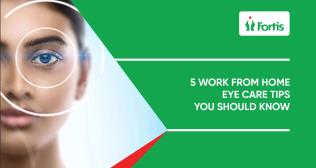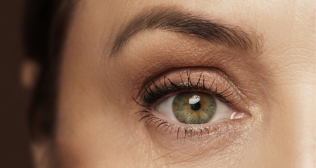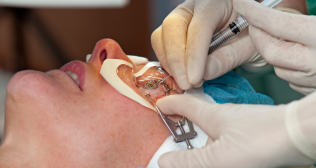
Corneal Ulcers: Early Signs, Treatment, and Prevention
Our vision is one of our most precious senses, and it depends entirely on the health of our eyes. The cornea, the clear, dome-shaped outer layer of the eye, acts as a protective window, bending light to help us see clearly. When this vital barrier is compromised by an open sore, it leads to a serious and painful condition known as a corneal ulcer. This is not just a minor irritation; it is a true ophthalmological emergency that can threaten your sight.
Any sudden, severe eye pain or change in vision should be taken seriously. Understanding the causes, recognizing the urgent symptoms, and knowing the importance of immediate treatment are critical for preventing long-term damage and preserving your vision.
What Is a Corneal Ulcer?
A corneal ulcer is an open sore or erosion on the surface of the cornea. It is often the result of an infection, but it can also be caused by severe dry eye or physical injury. It's important to differentiate an ulcer from a corneal abrasion, which is a simple scratch on the cornea. While an abrasion is painful, an ulcer is a deeper defect that involves inflammation and the death of corneal tissue. An untreated abrasion can easily become infected and develop into an ulcer.
Recognizing the Corneal Ulcer Signs and Symptoms
The body sends clear warning signals when something is wrong with the eye. The corneal ulcer signs and symptoms are typically intense and should never be ignored. Prompt medical attention is crucial if you experience any of the following.
Key Corneal Ulcer Symptoms
- Severe Eye Pain: This is often the first and most prominent symptom. The pain can be sharp and constant.
- Redness and Inflammation: The white part of the eye (sclera) may become very red and bloodshot.
- Foreign Body Sensation: A persistent feeling that there is something gritty or sandy in your eye.
- Excessive Tearing: The eye may water profusely in response to the irritation.
- Pus or Discharge: A thick, yellowish or greenish discharge from the eye is a common sign of infection.
- Blurred or Hazy Vision: The inflammation and swelling can interfere with the cornea's clarity, affecting your vision.
- Sensitivity to Light (Photophobia): A strong aversion to bright lights is a very common symptom.
- Visible White Spot: In some cases, you may be able to see a grayish-white, opaque spot on the cornea. This is the ulcer itself.
Common Causes of a Corneal Ulcer
Infection is by far the most common cause of a corneal ulcer. Microscopic organisms can breach the cornea's defenses, especially if the surface has already been compromised by a scratch or the improper use of contact lenses.
Infectious Causes
- Bacterial Infections: This is the most frequent cause, especially among contact lens wearers. Improper cleaning, sleeping in lenses, or using contaminated lens cases can introduce bacteria like Staphylococcus aureus or Pseudomonas aeruginosa to the eye.
- Viral Infections: The Herpes Simplex Virus (HSV), which causes cold sores, and the Varicella-Zoster Virus (VZV), which causes chickenpox and shingles, can both cause corneal ulcers.
- Fungal Infections: This type is less common but can occur after an eye injury involving plant material, like a tree branch. It can also affect people with weakened immune systems.
- Parasitic Infections (Acanthamoeba Keratitis): This is a rare but very serious infection caused by a microscopic amoeba found in water and soil. It almost exclusively affects contact lens wearers who expose their lenses to water by swimming, using a hot tub, or rinsing their lenses or case with tap water.
Non-Infectious Causes
- Severe Dry Eye Syndrome: A lack of adequate tear production can leave the cornea unprotected and vulnerable to breakdown.
- Eye Injuries: A significant scratch, scrape, or chemical burn can damage the cornea and lead to an ulcer.
- Autoimmune Diseases: Conditions like rheumatoid arthritis can sometimes cause corneal thinning and ulceration.
The Risks of Delay: Corneal Ulcer Complications
Delaying treatment for a corneal ulcer can have devastating consequences for your vision. The potential corneal ulcer complications are severe and include:
- Corneal Scarring: As the ulcer heals, it can leave behind a scar that can permanently impair vision if it is in the central visual axis.
- Perforation of the Cornea: A deep ulcer can eat through the entire thickness of the cornea, creating a hole that can lead to the collapse of the eyeball.
- Spread of Infection: The infection can spread inside the eye (endophthalmitis) or lead to the development of glaucoma.
- Permanent Vision Loss: In the worst-case scenario, severe scarring or uncontrolled infection can lead to partial or complete blindness in the affected eye.
Diagnosis and Eye Ulcer Treatment
An ophthalmologist (eye doctor) will diagnose a corneal ulcer using a specialized microscope called a slit lamp. They will often use eye drops containing a dye called fluorescein, which makes the ulcer glow under a blue light, allowing them to see its size and shape clearly. A tiny scrape of the ulcer may be taken for a culture to identify the specific organism causing the infection.
The primary eye ulcer treatment is aggressive, frequent use of medicated eye drops.
- Antibiotic, Antifungal, or Antiviral Drops: The type of drop prescribed depends entirely on the cause of the infection. Treatment must be started immediately.
- Frequent Dosing: You may be instructed to put drops in your eye as often as every 15-30 minutes, even through the night, for the first few days to fight the infection aggressively.
- Pain Management: Oral pain medication may be recommended to manage discomfort.
- Corneal Transplant: If the ulcer causes significant scarring that impairs vision, or if the cornea perforates, a corneal transplant (keratoplasty) may be necessary.
Protecting Your Vision is Paramount
A corneal ulcer is a serious medical condition that represents a direct threat to your sight. Any of the key symptoms, especially severe eye pain, redness, discharge, or changes in vision, should be treated as a medical emergency. Never wait to see if it gets better on its own.
By seeking immediate care from an ophthalmologist, you give yourself the best possible chance to fight the infection, minimize complications, and preserve your precious vision. Your eyes are irreplaceable; protecting them should always be your highest priority.
Frequently Asked Questions
1. Can a corneal ulcer heal on its own?
Ans. No. An untreated corneal ulcer will almost always worsen, leading to severe complications and potential vision loss. It requires immediate medical treatment.
2. How long does it take for a corneal ulcer to heal?
Ans. Healing time varies greatly depending on the size, depth, and cause of the ulcer. Minor ulcers may heal within a week or two, while more severe cases can take several weeks or even months.
3. Is a corneal ulcer contagious?
Ans. The ulcer itself is not contagious. However, the infectious bacteria or virus that caused the ulcer can be spread to others through direct contact.
4. What is the main cause of corneal ulcers in contact lens wearers?
Ans. The most common cause is improper hygiene. Sleeping in lenses, not cleaning them properly, or exposing them to tap water can lead to severe bacterial or parasitic infections.
5. Will I go blind from a corneal ulcer?
Ans. Blindness is one of the most serious corneal ulcer complications and is a real risk if the condition is left untreated. However, with prompt and aggressive medical treatment, vision can almost always be saved.



















